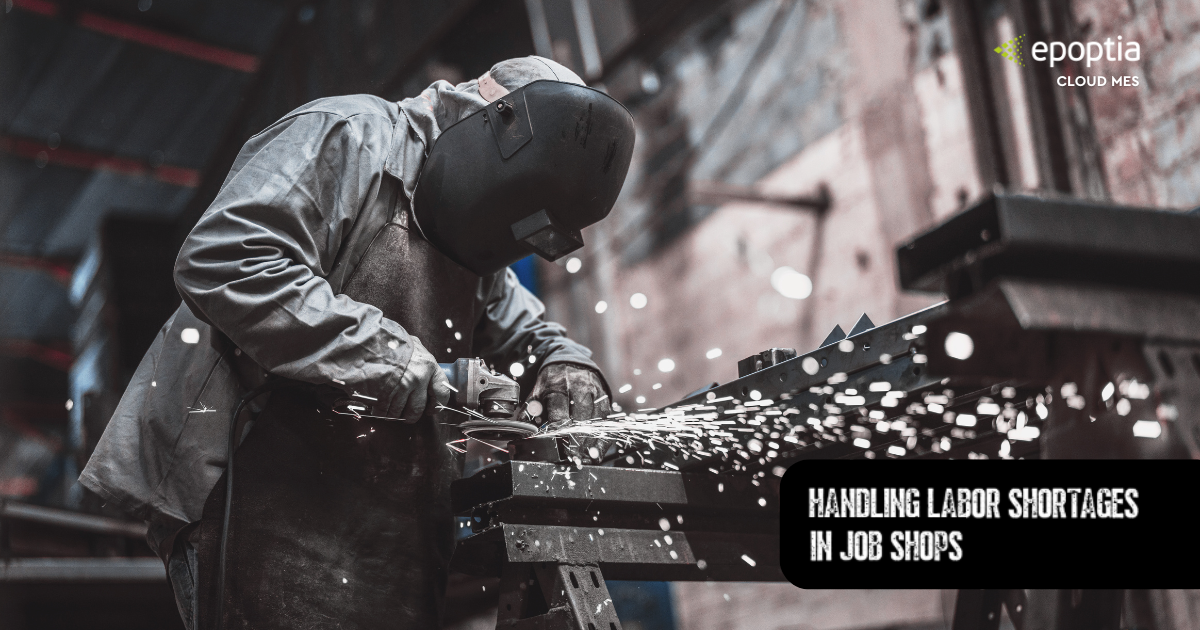Learn how to tackle the workforce labor shortages crisis in job shop manufacturing with practical solutions that work
Primarily, with the manufacturing industry facing persistent and growing labor shortages, job shops are feeling the pressure to adapt like never before. Moreover, the competition for skilled workers is fiercer than ever, forcing shops to find innovative ways to maintain productivity, meet customer demands, and continue scaling their businesses. Finding the right balance between workforce management, training, and technology adoption is crucial.
In this article, we will explore practical, actionable solutions—including automation and Manufacturing Execution Systems (MES)—that can help job shops overcome labor shortages, build resilient teams, and stay competitive in today’s challenging manufacturing landscape.
Understanding the Causes of Labor Shortages
First, it is crucial to understand why labor shortages occur in the manufacturing sector. Several interconnected factors contribute to this ongoing challenge:
- Aging Workforce: Many experienced workers are reaching retirement age, leaving a significant gap in knowledge and technical skills that younger generations are not filling quickly enough.
- Skills Gap: Modern manufacturing requires advanced technical skills, but there’s a lack of qualified candidates who meet these evolving demands.
- Industry Perception: Younger workers often perceive manufacturing jobs as outdated or less attractive compared to technology or service industry careers.
- Geographic Imbalances: In some regions, there simply aren’t enough workers living nearby to support local manufacturing operations.
Thus, by identifying and understanding these causes, job shops can better tailor their strategies to address the underlying issues and create targeted, effective workforce solutions.
Practical Solutions to Overcome Labor Shortages
1. Cross-Train Your Workforce
Cross-training employees is one of the most effective ways to build resilience against staffing gaps. By developing a more flexible and versatile workforce, job shops can ensure that production continues smoothly, even when specific team members are unavailable or new employees are onboarding.
Moreover, cross-training improves employee engagement, increases motivation, and opens clear pathways for career growth within the company, which in turn helps with long-term retention.
2. Invest in Automation, Robotics, and MES
One of the most transformative solutions to tackle labor shortages is automation combined with Manufacturing Execution Systems (MES). Automation, including collaborative robots (cobots), automated guided vehicles (AGVs), and CNC machine automation, can take over repetitive, dangerous, or time-consuming tasks, freeing up human workers to focus on more strategic activities.
Meanwhile, MES software acts as the digital backbone of the production floor, orchestrating workflows, tracking real-time performance, and optimizing resource allocation without needing additional human oversight.
Example: A precision job shop integrated an MES platform alongside robotic welders. As a result, they achieved a 40% increase in overall equipment effectiveness (OEE) and reduced labor dependency by 30% without sacrificing quality.
Thus, by combining automation with a powerful MES, job shops gain unprecedented control over production, reduce errors, maximize efficiency, and better withstand workforce fluctuations.
Pro Tip: Start by automating low-skill and high-repetition tasks first, then gradually extend automation capabilities to more complex operations. Ensure your MES is scalable to grow with your shop’s needs.
3. Enhance Recruitment and Talent Pipeline Strategies
Building strong, proactive recruitment strategies remains essential. Partnerships with local trade schools, community colleges, and workforce development organizations can help job shops develop a sustainable talent pipeline.
Moreover, showcasing the use of modern technology—such as MES, IoT devices, and smart robotics—in recruitment campaigns can make your job shop far more attractive to younger, tech-oriented candidates.
By presenting manufacturing as a high-tech, innovative career path, job shops can change perceptions and bring in the next generation of skilled workers.
4. Improve Workplace Culture and Employee Retention
Creating a positive and supportive workplace culture is vital for retaining valuable employees, especially in a competitive labor market. Recognition programs, transparent advancement paths, investment in professional development, and a focus on employee well-being can significantly impact retention rates.
By focusing on retention, job shops minimize the costs associated with constant rehiring, retraining, and lost productivity, while also strengthening their reputation as a desirable employer in the community.
Real-World Sucess Stories
Several job shops have successfully navigated labor shortages by implementing multi-pronged strategies focused on automation and digitalization.
One standout example comes from a global manufacturing enterprise in Texas, which recently completed the installation of the Epoptia MES platform. By integrating Epoptia into their production processes, they gained real-time visibility over their operations, streamlined their workflows, and minimized production inefficiencies.
Key results included:
- A significant reduction in downtime, thanks to real-time production monitoring and proactive scheduling.
- Improved resource allocation, allowing their existing workforce to operate more efficiently across multiple production lines.
- Increased overall throughput, without the immediate need to hire additional staff.
By leveraging the power of Epoptia MES, this manufacturer turned operational challenges into an opportunity to enhance productivity and future-proof their business against ongoing labor shortages.
This success story is a clear reminder that smart automation and MES solutions are not just beneficial—they are increasingly essential for job shops aiming to stay competitive in today’s fast-changing manufacturing landscape.
Conclusion
To sum up, handling labor shortages requires a proactive, strategic, and forward-looking approach. By cross-training employees, investing in smart automation and MES systems, enhancing recruitment strategies, and fostering a strong workplace culture, job shops can build resilience and long-term competitiveness.
Rather than seeing the labor shortage as a roadblock, forward-thinking job shops are using it as a catalyst to innovate, optimize, and grow.
Are you ready to future-proof your operations and turn today’s labor challenges into tomorrow’s opportunities?
Contact us today for a free consultation and discover how our tailored automation and MES solutions can help your job shop thrive in the evolving manufacturing landscape!
For more information, check https://bit.ly/3vYnb4f.




















